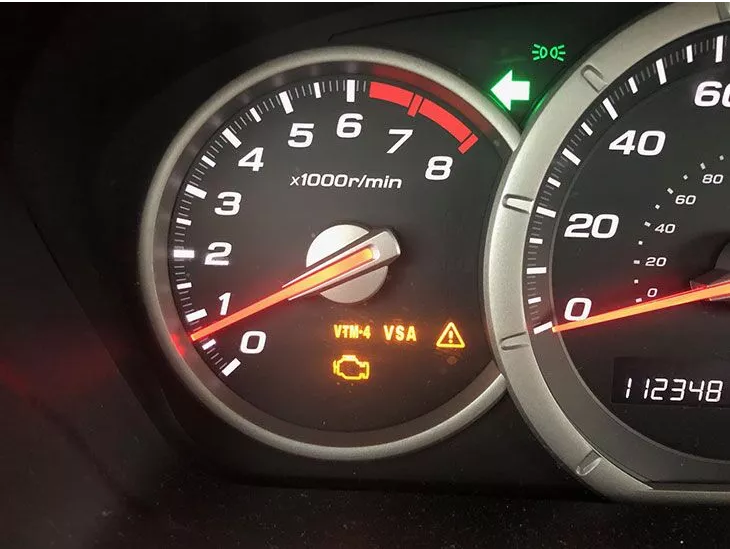
Why Is My Honda Pilot VTM-4 Warning Light On? The all-wheel-drive system of the Honda Pilot is rather ingenious, since it allows for variable torque distribution not only between the front and back axles of the vehicle, but also between the left and right rear wheels.
However, several problems have been observed throughout the years, despite the fact that it works well in general and guarantees good traction on challenging routes.
The first two generations of all-wheel-drive Honda Pilots were equipped with an older version of this technology that was referred to as VTM-4. The third-generation Honda Pilot, on the other hand, features the most recent i-VTM4 system.
However, their modes of operation are extremely comparable; the primary difference between them is that the more recent i-VTM4 incorporates a greater degree of intelligence into the algorithms that control the distribution of torque to the rear axle. This results in enhanced responsiveness and enhanced stability in extreme driving conditions. But what if things don’t go according to plan?
On a Honda Pilot, what does it mean when the VTM-4 light comes on?
What exactly does it signify when the VTM-4 light comes on in a Honda Pilot, and does it portend a potentially catastrophic outcome? First things first, let’s have a look at what the VTM-4 is.
The term “VTM-4,” which stands for “Variable Torque Management” four-wheel drive system, refers to the electronically-controlled four-wheel drive system that is standard on Honda’s high-end sport utility vehicles (SUVs).

Be careful not to mistake this with Honda’s “Real Time AWD,” which was utilized in earlier generations of the CR-V and HR-V. That system does not have the VTM-4’s smart rear differential and does not possess the same torque-distribution capabilities as the full-fat VTM-4 or i-VTM4 systems. If the VTM-4 warning light turns on in your Honda Pilot, it means that there is an issue with this particular system.
However, it is essential to keep in mind that there is a distinct difference between the warning light for the VTM-4 (or i-VTM4) that is installed on the gauge display, and the confirmation light that is located inside the VTM-4 switch that is mounted on the dashboard, to the left of the audio system.
The VTM-4 warning light that is located in the instrument cluster of the Honda Pilot should only turn on while the engine is being started. After the engine has been started, the light should go off within a second or two. After then, it is intended to stay off, even if the smart rear differential is on, because that is how it’s supposed to work.
If the VTM-4 cluster warning light illuminates while you are driving, it is an indication that there is a problem with the operation of the rear differential. The reason of this problem might be one of a surprising number of various possibilities.
The indicator light within the switch illuminates to let you know that the “VTM-4 Lock Mode” has been properly activated.
However, the confirmation light should only be activated when you have purposefully selected Lock mode. Additionally, the button should be pressed once again to disengage Lock as soon as it is no longer necessary or upon returning to hard surfaces. When you do that, the confirmation light will go off, and everything will be OK after that.
Why is the VTM-4 light on your Honda Pilot on when it shouldn’t be?
The VTM-4 warning light on a Honda Pilot may come on for a variety of reasons, some of which are readily fixed, such as problems with the wiring harness or sensors, and others, which are part of a much bigger collection of difficulties, including the following:
There is a possibility that the pressure or temperature sensors for the rear differential are broken.
It’s possible that the rear differential oil level is low because of a leak or an earlier instance of overheating.
There is a possibility that rodents have caused damage to the vehicle’s wire harness.
It’s possible that there’s a significant issue with the vehicle’s engine or its emission controls.
2003–2008: The Years Covered by the First Generation of Honda Pilots
The VTM-4 warning light will most likely turn on in first-generation (2003-2008) Honda Pilots because of a lack of differential fluid or a sensor mistake; according to reports, models from the years 2004 and 2005 are more likely to suffer from these conditions.
2009-2022 The Second Generation Honda Pilot and the Third Generation Honda Pilot
These potential causes are shared by the second and third generations of the Honda Pilot (model years 2009-2015 and 2016-2022, respectively), but there is also the possibility that there may be issues with the engine or the emission control system. In this scenario, the all-wheel drive system will automatically disengage and the warning light will turn on.
This appears to be most common in instances constructed in 2011, 2012, and 2013; this is generally in line with the model years of those Honda Pilots, which are also the most likely to have problems with pollution control.

What Should I Do When the VTM-4 Light on My Honda Pilot Begins to Flash?
If the warning light is flashing, however, you should pull over as soon as you safely can. A warning light that remains on is a sign of a less urgent problem. If the VTM-4 warning light on your Honda Pilot is blinking, the owner’s handbook instructs you to pull over as soon as possible, put the gearbox into Park, and let the engine to idling until the VTM-4 light stops flashing.
If it remains flashing even after a long length of time spent idling, turn off the engine and contact a towing agency to have your Honda Pilot transported on a flatbed truck to a reliable repair facility. In this instance, a blinking Honda Pilot VTM-4 light indicates that there is a significant issue with the rear differential, and continuing to drive the vehicle would most certainly cause more damage.
Do I need to turn the VTM-4 light off before I drive my Honda Pilot?
If the VTM-4 warning light on your Honda Pilot is blinking, it means that there is an issue that requires immediate attention from a Honda-certified technician. However, if the VTM-4 warning light remains lit, it simply indicates that the all-wheel drive system has been disabled as a result of an issue.
In this particular situation, the control system has isolated the issue by releasing the torque take-off from the front transaxle and unlocking the clutches on the VTM-4. As a result, your all-wheel-drive Honda Pilot has been converted into a front-wheel-drive-only vehicle.
You are permitted to continue driving even if the light is always illuminated; however, you should take into account the fact that the all-wheel drive (AWD) system is not operational and that it will require care very soon. Unfortuitously, the only method to properly deal with a lit VTM-4 light on a Honda Pilot is to perform an appropriate diagnostic effort and effective repairs.
How to Turn Off the VTM-4 and/or the Check Engine Light on a Honda Pilot
The cause of the malfunction that resulted in the illumination of the VTM-4 warning light determines which solution will be effective in resolving the issue.
Two of the potential solutions are straightforward do-it-yourself projects that are well within the capabilities of a home mechanic with average skills. Other issues are more difficult to handle and will require the assistance of trained professionals. If you are wondering how to turn off a Honda Pilot VTM-4 light, the following is a checklist that you should follow:
Check for low fluid levels in the VTM-4. If the VTM-4 rear differential is just low on fluid, the answer would be to replace it. Check for low fluid levels in the VTM-4. Because it is highly unlikely that an older Pilot would have been serviced with new VTM-4 fluid in the recent past, this is one of the most prevalent causes of VTM-4 difficulties. Honda advises that the VTM-4 fluid be replaced every 7,500 miles. First, you should change the fluid, and then check to see whether the warning light is still on.
Check all of the sensors in the VTM-4 unit. There are several sensors in the VTM-4 unit that have the potential to trigger the VTM-4 warning light, the fluid temperature sensor being the most likely offender.
Due to the fact that this failure can typically be traced back to corrosion of the wiring connections, problems with this sensor are more prone to occur in cars that come from regions that make use of road salt.
It is a simple issue that can be fixed by removing a little cover plate, then unbolting and removing the sensor, and then installing a brand new sensor in its place. Remember to apply lubricant to the electrical connections to avoid the corrosion issue from occurring again, then reinstall the cover plate and clear the error code from the OBD-II system.
Check for problems with the wiring harness. The Honda Pilot has environmentally friendly, soy-based electrical insulation, and rodents appear to find this to be a really delicious feast.
There have been several cases of the VTM-4 warning light coming on when there was nothing more serious than a few chewed wires causing the problem; nonetheless, the damage may be substantial enough to require the assistance of a professional in order to be repaired properly.
Because rats do not discriminate when it comes to the wiring harnesses of different systems that they chew through, the warning light for the VTM-4 may come on in addition to the other dashboard warning lights if this is the issue.
Consider engine difficulties and emission control system failures:
These are the kinds of problems that you should do all in your power to avoid since they may very rapidly result in a costly repair to the engine.
If you have a Honda Pilot, you will most likely become aware of this issue when both the VTM-4 light and the check engine light come on at the same time. Additionally, the on-board diagnostic system may display the error code P3400 as confirmation.
The VCM (Variable Cylinder Control) technology, which was installed in first-generation Pilots manufactured after 2006 as well as all second- and third-generation vehicles, is the source of the issue. It is the responsibility of the VCM to turn off the fuel supply to the rear cylinder bank when the load on the engine is low; nevertheless, the VCM has the unpleasant side effect of creating excessive oil consumption.
In the case that this occurs, the spark plugs will ultimately become clogged with soot, which will result in misfires. The moment the engine’s control system recognizes a pattern of repeated misfires, it immediately enters limp-home mode, completely disengages the all-wheel drive system, and turns on both the Check Engine Light and the VTM-4 warning light on the Honda Pilot. This happens as soon as the system detects the problem.
How Much Will It Set You Back To Repair It?
If the issue with the Honda Pilot’s VTM-4 is attributable to a sensor issue in the rear differential assembly, the repair will be surprisingly reasonable.
This is due to the fact that an OEM temperature sensor can be obtained for less than $70, and it is a simple DIY replacement exercise. VTM-4 fluid is also very reasonably priced, coming in at less than $30 for a gallon, and refilling it is a simple and basic project that can be done by the homeowner themselves.
The issue of oil consumption and emission control can be fixed in a variety of ways, ranging from replacing the engine entirely in extreme cases to merely reprogramming the engine control unit and installing a new set of spark plugs. However, the nature and extent of the oil consumption problem determines which of these solutions will be necessary.
This matter requires the attention of trained professionals and may even be the subject of a class-action lawsuit or an extension of Honda’s engine warranty to eight years.
Check with your local dealership to see if your Honda Pilot is protected for this well-known issue. However, keep in mind that this issue did not result in a recall, so only vehicles with active warranties will be eligible for Honda’s extended insurance.
Last but not least, if the VTM-4 or i-VTM4 unit itself has to be changed, you should plan on spending at least $3,700 for the assembly. This does not include the cost of oil or the labor to install it. When the VTM-4 warning light begins blinking, there is sufficient justification on its own to justify pulling over.
As far as the VCM issue is concerned, you should check with your local Honda dealership to see if your Pilot is included in the warranty extension for this matter. Emission control malfunctions are the primary reason why a Honda Pilot’s VTM-4 warning will light up, aside from sensor- or wiring-related failures, which are also possible causes.
Why Is My Honda Pilot VTM-4 Warning Light On?– fitnexboost.com
